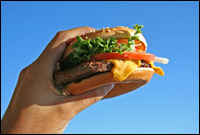Dear Umbra,
I finally went vegetarian several months ago, and one of my main reasons was the environmental impact of meat production. The other day, however, a friend pointed out that soy foods take a great deal of energy to produce too. So is there really that big of an environmental difference between TVP [textured vegetable protein] and free-range beef? And how does dairy compare? Should I just try to stick to nuts and beans?
Sarah Amandes
Brooklyn, N.Y.
Dearest Sarah,
Have you ever wondered whether TVP might be the hot dog of soy products? All the soy boogers and intestines, mushed up into a bland-seeming “food”? Just a thought.

Here comes the bun.
Yes, there is a big environmental difference between eating meat and not eating meat. We are concerned with land use, water use, water pollution, air pollution, habitat, and packaging, and animals have a larger impact than plants in most of these categories. I’ll go over some numbers from the Union of Concerned Scientists’ Consumer’s Guide to Effective Environmental Choices (mwah!) and an article from the American Journal of Clinical Nutrition, which surveyed European life-cycle studies of food production.
The journal picked soy studies for a comparison, lucky for you. Meat production took more land (6 to 17 times as much), water (4.4 to 26 times), fossil fuels (6 to 20 times), and biocides (a lumped-together category of pesticides and chemicals used in processing — 6 times as much). In fact, meat lost in every category. When processing and transport is factored in to the equation, the difference becomes less extreme, but it’s still there. Meat-based diets use about twice as many environmental resources as soy-based diets. Despite concerns about deforestation and genetic engineering, soy appears to be the winner here.
If you are thinking of veggie but non-soy choices, take a look at the numbers from UCS, which compared red meat and pasta. Meat used 20 times the land, and generated thrice the greenhouse-gas emissions. Ye who have obeyed my Buy the Book Command know UCS splits water pollution into two categories, common (caused by soil and biological matter) and toxic. Meat was worse in the former category by a factor of 17, and in the latter by a factor of 5. UCS also estimates that a quarter of the threats and damage to U.S. ecosystems and wildlife comes from the production of the meat and poultry we eat.
It makes sense. In our current system, we grow plants and feed them to animals, which we then eat. Land and other resources are used during both phases of production. The animals are densely raised, which intensifies their ecological impacts. (Giant, overflowing hog-waste ponds are a dramatic example of this problem.) If we have a plant-based diet, we reduce animal grazing, manure management, biocide treatments (I like our new word), packaging, etc. And dairy is also better than meat, although both come from animals. Dairy cows produce many times their body weight in milk each year, while cattle produce less than their body weight in meat. Using a somewhat similar amount of land and feed, dairy herds produce three and a half times the weight in food.
Let’s be careful not to make the situation too black and white, though. Life-cycle analyses can help separate and elucidate factors at play, but they also raise questions. There is some indication in these studies that sustainably raised, locally procured meat-based diets can hold their own, environmentally, against heavily processed, far-shipped veggie diets. So I prefer to believe that eating my local bacon is better than eating frozen veggie burgers, not just gastronomically but ecologically. Of course, we still may eat veg for a multitude of other reasons. Like, for example, baby sheep are cute.
TVPily,
Umbra

